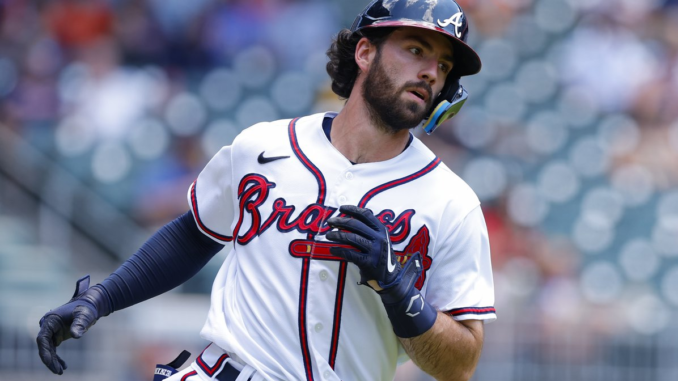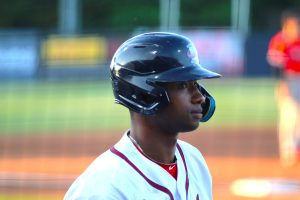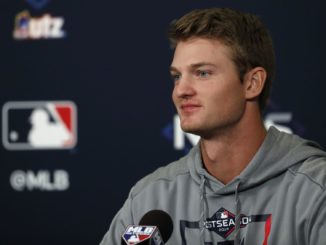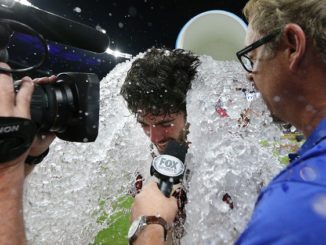
It was in many ways a remarkable season for the Atlanta Braves. With a weird, abbreviated offseason and shortened spring training highlighted by the dramatic non-signing of long-time star first baseman Freddie Freeman followed by the biggest trade the franchise had executed in 15 years to bring in replacement Matt Olson and lingering questions about when Ronald Acuña Jr. would be available, the Braves got off to a difficult start to the season. Things turned around as the calendar was about to flip to June, mostly thanks to three factors: the promotion and subsequent brilliant play of rookie centerfielder Michael Harris II, the insertion of rookie right-hander Spencer Strider into the starting rotation, and the return of Acuña to right field on a regular basis. The Braves went on an amazing 78-34 run starting on June 1 culminating in an amazing sweep of the New York Mets in Atlanta in the second-to-last series of the season to all but clinch the NL East, snatching their 5th straight divisional pennant after spotting the Mets 10.5 games.
Yeah, I know… “and then what happened?” What happened was that the Braves got trounced in the NLDS by the third-place Philadelphia Phillies. In 2021 the Braves played well and got lucky and had a magical playoff run. In 2022 the Braves played poorly and got unlucky (and the Phillies played well). And now I get to write this post earlier than I was able to last year.
Regardless, the Atlanta Braves had a great season and are set up to be a contending club for the rest of this decade already.
Taking Stock
While the season didn’t end the way anyone likely reading this wanted it to, 2022 was undoubtedly a banner year for the balance sheet of the Atlanta National League Baseball Club, LLC. Attendance at Truist Park soared past 3 million fans for the first time, and it was the highest yearly attendance in 22 years for the club. Liberty Media disclosed in their last investor report that the team made $260 million in revenue in the 2nd quarter alone, and operating revenue rose to $57 million. Approximately $13 million of that derived from The Battery, the mixed-use adjacent complex that continued to be lively, and not just on game day. For 2023 the Braves will also see more revenue from their regional broadcast deal with Bally Sports, up another $20 million from 2021.
With this windfall, it’s not surprising to hear Braves Chairman Terry McQuirk talk about the Braves eventually having a top-5 payroll in the majors. The Braves don’t disclose their exact payroll budget, but after a season where the 40-man payroll was estimated to be near $220 million, the average of the top 5 payrolls of 2021 is roughly $264 million, so the Braves aren’t that far away.
The Braves, with one notable exception, have locked up the core of their team for 2022 already. Infielders Olson, Ozzie Albies, Orlando Arcia, and Austin Riley; outfielders Acuña, Harris, Eddie Rosario, and Marcell Ozuna; catchers Travis d’Arnaud and Manny Piña; and pitchers Charlie Morton, Raisel Iglesias, Kirby Yates, Collin McHugh, and Strider are collectively guaranteed $153.8 million. Then there are the arbitration-eligible players, which are as follows with estimated salaries from Steve Adams of MLB Trade Rumors:
- Max Fried, $12.2 million
- A.J. Minter, $5 million
- Mike Soroka, $2.8 million
- Tyler Matzek, $1.8 million
- Guillermo Heredia, $1.1 million
- Silvino Bracho, $900,000
Some of these players may be non-tendered or negotiate a different salary, but for our rough purposes we’ll add these to the guaranteed salaries for a total of $177.6 million. Finally, around 15 players will be pre-arb eligible, and at least 8 of those will likely be in the minor leagues at any given time. With that approximate $6 million added, that gives us a baseline payroll of $183.6 million before adding free agents or making trades. I am conservatively estimating that the 2022 payroll will be about 10% higher than the 2021 end-of-season payroll, so that would be a total budget of $242 million, which would give the front office $58.4 million to go to market with, though some amount of that would be reserved for potential in-season trades.
The good news is that the team as constituted would already be quite good. Starters can marked down in pen at six of the nine line-up spots (leaving shortstop, left field, and designated hitter), with decent options for those last three positions. The rotation already would be a quality one headed by Fried, Strider, Wright, Morton, and one of Soroka, Ian Anderson, Bryce Elder, Kyle Muller, or possibly Jake Odorizzi if he elects to take his player option to remain with the team. The bullpen would be a little thinner without closer Kenley Jansen or middle reliever Jesse Chavez, but mid-year acquisition Iglesias would be a more than competent 9th-inning replacement for Jansen. In short, the team will start the off-season in a position of enviable strength.
Priority 1: Sign a Shortstop
With Dansby Swanson likely to test the free agent waters, the in-house options are veteran Orlando Arcia and/or youngster Vaughn Grissom. Arcia has the defensive chops but is only an occasional offensive contributor. Grissom has more offensive upside but his defense at shortstop isn’t likely to be championship-caliber for a whole season.
The obvious solution would be to re-sign Swanson, the Marietta native who’s trade to the Braves in 2015 was a pivotal moment in the rebuild. That said, after watching franchise cornerstone Freddie Freeman and the team fail to come to agreement despite both parties highly amiable to staying together, it doesn’t take much imagination to see something similar happen with Swanson, despite his leadership position with the team, anchoring the team’s defense, and coming off his best all-round season as a major leaguer as he enters his prime years. After all, those things will also make him attractive to other teams as well.
There will likely be three other shortstops in the high-end of the market this offseason: Trea Turner, Carlos Correa, and Xander Bogaerts. Both Correa and Bogaerts are under contract but have opt-out clauses that they are likely to trigger.
Correa has championship pedigree and leadership credentials in addition to being a significant offensive threat. He’s also slightly younger than Swanson. Correa was an elite defender as recently as 2021, though his defensive metrics were disappointing in 2022, his first (and likely only) season with the Twins.
Turner was a long-time thorn in Atlanta’s side when he was with the Washington Nationals. He’s coming off a “down” year in which he still hit .298/.466/.809. At 29 years old, Turner is slightly older than Correa and Swanson but still in his prime. While not as strong defensively as Swanson or Correa, Turner is a competent defender.
Last but not least, Bogaerts has been arguably the best offensive shortstop in the American League the last five years (only Correa could really give an argument), and is coming off his best-rated defensive season of his career on top of having one of his best offensive seasons. Bogaerts just turned 30 years old so is the oldest of the four, though again is still in his prime.
On the trade front, Milwaukee’s Willy Adames would be an interesting possibility should the Brew Crew look to re-tool after missing the playoffs for the first time in five seasons. Adames had a career year in 2021 but fell off this season. Adames just turned 27 and would be the youngest candidate (outside of Grissom) and still has some upside. He is under team control for two seasons.
The Braves wouldn’t do bad with any of these five. With his age and pedigree, Correa would seem the one most likely to command the biggest contract, with the 10-year/$325 million deal that the Rangers signed Corey Seager to last year as a template. Even with their newfound payroll muscle however, Atlanta doesn’t seem likely to want to play in that kind of rarified air.
Priority 2: Shore Up Left Field/DH

On one hand, the Braves already have somewhat of a credible LF/DH situation between Eddie Rosario, Marcell Ozuna, and William Contreras.
Eddie Rosario’s season was washed after an undiagnosed detached retina had him hitting .163/.091/.254 when he finally had surgery. He was rusty when he returned and ended up hitting .212/.259/.328 for the season. He would undoubtedly improve on those numbers given a full spring and health.
Catcher William Contreras was supposed to spend most of the season with the Gwinnett Stripers to work on his defense after Atlanta signed veteran Manny Piña to back up starter Travis d’Arnaud. After Piña hurt his wrist and had to have surgery that put him out for the year however, Contreras found himself pressed into service and he made the most of it, hitting .277/.353/.504 and providing solid-average catcher defense. He was penciled into the line-up 31 times as the team’s designated hitter, second on the team behind Ozuna, and ended up starting the All-Star game at the position.
Marcell Ozuna from the Braves is coming off his second consecutive sub-par season, hitting .226/.274/.413. He still hits the ball very hard when he makes contact and his 23 home runs is close to his career season average, but his strikeout and groundball rates went up, which is not a good combination. With Ozuna though, the on-field problems are only half the story. In August he was arrested for DUI in Gwinnett County, the latest brush with the law after initially being charged with aggravated assault and battery in Fulton County in 2021. Those changes were eventually dropped following Ozuna completing 200 hours of community service, an anger management program, and a 24-week family violence intervention program.
So that all said, it’s somewhat credible… but it’s not quite desirable. Rosario is a below average defender in left field and would require a right-handed platoon partner. Ozuna makes a poor platoon partner given his inability to contribute defensively and his struggles against left-handed pitching. Contreras is a fine designated hitter, but as also the back-up catcher it leaves the team vulnerable to losing the DH if he has to change positions mid-game.
Ideally, the Braves would be able to trade Ozuna — or release him if no trade manifests. There were reports of a possible trade at the deadline that would have sent Ozuna to Miami for Avisail Garcia. Garcia is owed $41 million over the next three seasons instead of Ozuna’s $37 million over the next two, and I am not certain the Braves wouldn’t be better off simply releasing Ozuna and taking the $37 million hit.
An in-house option, though not perhaps at the start of the year, could be prospect Justyn-Henry Malloy, who ended the season at Gwinnett and is currently seeing action in the Arizona Fall League. An advanced hitter, Malloy only started playing left field at mid-season, though early looks have been positive. If the Braves acquire another shortstop, its possible that Vaughn Grissom could make the move to left given an offseason to work at it.
Two solid free agent platoon options for left field are Adam Duvall and Robbie Grossman, both whom played for the Braves in 2021. Grossman would likely be available for a smaller amount, and would be a good option if the feeling is that Malloy would be able to take over the spot by mid-season. Duvall and Seattle Mariner Mitch Haniger would represent bounce-back candidates after seasons curtailed by injuries and likely could be had on one-year make-good deals. Former Royal and current Yankee Andrew Benintendi would be a more expensive option who may require a long-term deal to land. The Cadillac option would be newly-minted AL single-season home run champion Aaron Judge, who will likely command a multi-year deal with an average annual value well north of $30 million; this would not completely be outside of the Atlanta’s wherewithal, but it would likely keep the Braves from significantly investing elsewhere on the team.
Priority 3: Bullpen Depth
As has been a calling card for Atlanta the last several seasons, the bullpen was a strength of the team. Atlanta brought in free agents Kenley Jansen, Collin McHugh, and Kirby Yates to bolster bullpen stalwarts A.J. Minter and Tyler Matzek. Rookie Dylan Lee and minor league free agent Jackson Stephens did good work in the middle innings. Jesse Chavez was re-acquired — twice — and proved serviceable again each time. At the deadline, the front office brought in Angels closer Rasiel Iglesias to work as a primary set-up man for Jansen and he was brilliant, only allowing 1 earned run in 26.1 innings over the final 2 months of the season.
While Iglesias, Minter, McHugh, Lee, Stephens, and Yates look to remain for 2023, Jansen and Chavez will test free agency again while Matzek will miss the season after getting Tommy John surgery. Luke Jackson will also be a free agent after missing the 2022 season with his own TJS.
In-house options for spots include William Woods, Victor Vodnik, Brooks Wilson, Freddy Tarnok, Alan Rangel, and Darius Vines, as well as any starter who doesn’t grab the 5th-starter spot and could transition to the bullpen. Wilson carries the caveat that he also is coming back from TJS and likely would not be a candidate immediately.
Braves President of Baseball Operations Alex Anthopoulos has already made a point of publicly indicating a desire to re-sign Jansen, and a return at or near the one-year, $16 million price tag from 2021 seems doable for the club after Jansen lead the NL in saves. If Jansen does leave however, the Braves don’t necessarily need to fill the bullpen vacancy in the 9th; Iglesias has ample closing experience and could step into the role. Anthopoulos could deepen the bullpen from the middle. Free agent options there would include Mets left-hander Joely Rodríguez, who could step in for Matzek, or Cincinnati’s Justin Wilson.
Jesse Chavez and Luke Jackson would be candidates to re-sign, and both have expressed interest in returning to Atlanta.
Priority 4: Another Starting Pitcher Difference-Maker
The Atlanta rotation was a top-10 group in almost any category you can think of — ERA, FIP, WAR, and so on. Max Fried has established himself as a legitimate top-of-the-rotation ace while Kyle Wright finally established himself as a major league-caliber starter after years of fits and starts. Charlie Morton was re-upped to be the veteran warhorse, while rookie Spencer Strider only established a new franchise mark with a 38.3% strikeout rate.
Those four could be joined by one of several interesting possibilities. Ian Anderson was in the rotation most of the season, but was sent back down after he stopped being able to run his 4-seam fastball up in the zone or establish a credible third pitch. The right-hander posted a 3.25 ERA from 2020-21 however and is plenty talented enough to right the ship.
Former ace Mike Soroka finally returned to the pitcher’s mound late in August for six starts in the minor leagues after having two surgeries to repair a ruptured Achilles tendon. He showed that he was healthy and that he had good life on his pitches, especially his 2-seamer. He was however understandably rusty and had significant command issues. A non-rehab offseason would likely do him well in that regard.
Right-hander Bryce Elder made four starts in April as Atlanta was running a 6-man rotation, but couldn’t hold down the role. He pitched better in five starts down the stretch, including throwing the only complete game of the season for the staff, a six-hitter against the Nationals on September 26.
Finally, left-hander Kyle Muller showed much improved command at the AAA level in 2022. He was given three scattered starts for Atlanta, getting blown out in early May but throwing two solid outings later in the season. Muller’s year was interrupted mid-season after breaking his non-throwing hand catching a ball defensively during batting practice.
The Braves could go into spring training with any of those four a fine option for the 5th-starter spot. A wildcard right now is also Jake Odorizzi, a trade deadline acquisition from Houston who functioned as the 5th starter down the stretch. He has a player option that he could trigger that would either pay him $6.5 million to become a free agent or $12.5 million to remain with Atlanta.
But… Jacob deGrom.
The Florida native will reportedly opt out of the $30.5 million guarantee for 2023 with the New York Mets. It’s also rumored that one of the criteria for determining where he will pitch next would be closer proximity to his home state. With neither the Rays nor the Marlins realistic landing spots, you don’t have to look at a map for long to see that Atlanta is the next closest team. For Atlanta, it’s an opportunity to get one of the greatest pitchers in the game and hurt a division rival at the same time.
Of course, the question is of money and how much risk the Braves want to take on for a pitcher who hasn’t thrown over 100 innings since 2019. At 34 years old however, it doesn’t seem likely that deGrom will be asking for a contract of significant length, and Anthopoulos has shown a willingness to pay high yearly average salary on short-term deals.
Smart money is probably on the Braves bringing in a lower-cost veteran starter to compete with Anderson, Soroka, Elder, and Muller for innings (and that’s assuming Odorizzi decides to leave) and using their payroll to shore up the first three priorities.
But… Jacob deGrom.
I mean, look.
Jacob deGrom, 6th, 7th and 8th Ks.
Thru 3. 😳
This game is too easy for him. pic.twitter.com/RNNOCgcIV2
— Rob Friedman (@PitchingNinja) September 18, 2022




Leave a Reply